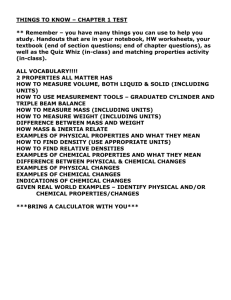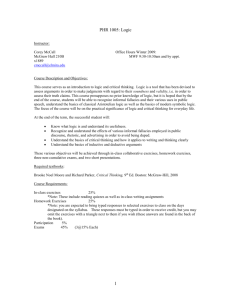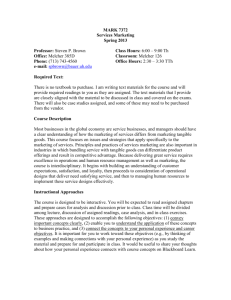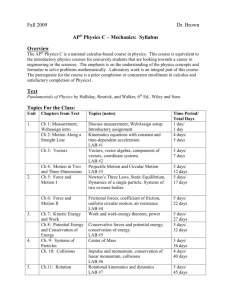Physics 101 syllabus - Error: Browser Problem
advertisement
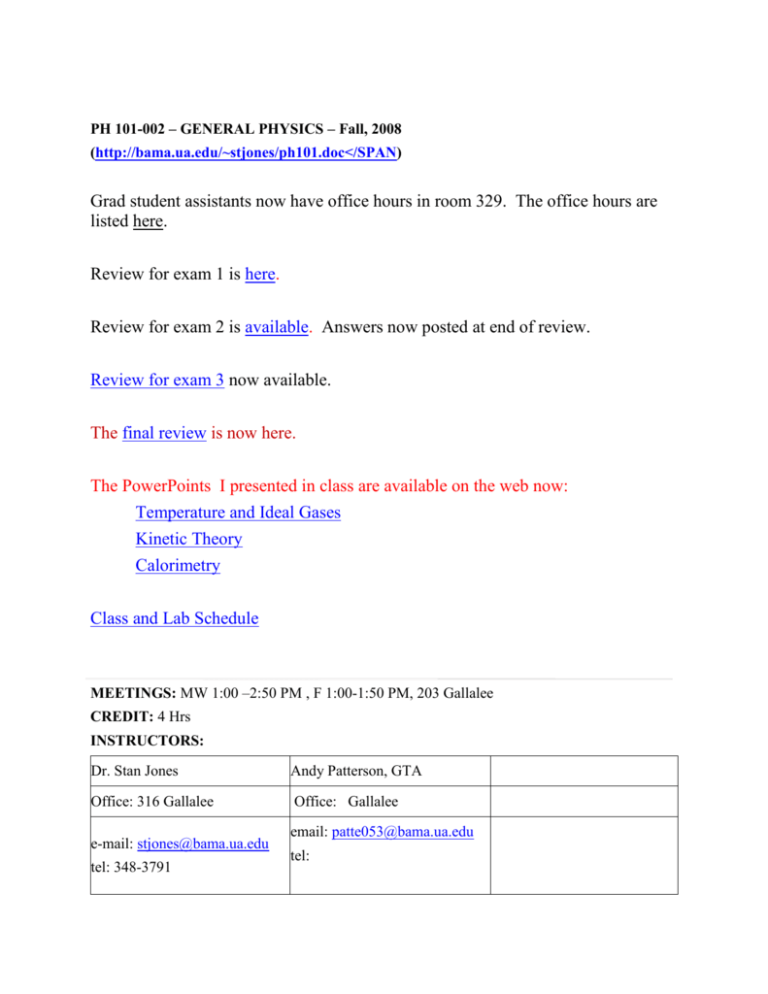
PH 101-002 – GENERAL PHYSICS – Fall, 2008 (http://bama.ua.edu/~stjones/ph101.doc</SPAN) Grad student assistants now have office hours in room 329. The office hours are listed here. Review for exam 1 is here. Review for exam 2 is available. Answers now posted at end of review. Review for exam 3 now available. The final review is now here. The PowerPoints I presented in class are available on the web now: Temperature and Ideal Gases Kinetic Theory Calorimetry Class and Lab Schedule MEETINGS: MW 1:00 –2:50 PM , F 1:00-1:50 PM, 203 Gallalee CREDIT: 4 Hrs INSTRUCTORS: Dr. Stan Jones Andy Patterson, GTA Office: 316 Gallalee Office: Gallalee e-mail: stjones@bama.ua.edu tel: 348-3791 email: patte053@bama.ua.edu tel: office hrs: MW 3:00 - 4:00 or any time my door is open TEXT: Serway and Faughn, College Physics, Vol. I, 7th Ed. PREREQUISITES: MATH 113 or MATH 115 GENERAL COURSE DESCRIPTION: This is an introductory algebra/trig-based course in classical mechanics, heat and waves for students in science. COURSE TOPICS: Kinematics in one and two dimensions, Newton's laws of motion, work and energy, conservation of energy, linear momentum, collisions, rotational motion, oscillations, gravitation, heat, waves. COURSE GOALS AND OBJECTIVES: Upon completion of the course, you should have a basic introductory understanding of classical mechanics on both a qualitative and quantitative level. You should be able to solve basic mechanics problems using algebra and trigonometry. You should then have the necessary background so that you can take PH102. Learning outcomes for 100- and 200-level physics courses 1.) Application of basics laws of physics: Students will be able to apply basic laws of physics to formulate a solution to a problem. 2.) Data and mathematical relationships representation: Students will be able to represent data and mathematical relationships using tables, equations, graphs and words. 3.) Draw conclusions from experimental data: Students will be able to draw valid conclusions from experimental data. 4.) Magnitude estimation and dimensional analysis Students will be able to estimate the magnitude of the solution to a problem and will be able to exclude wrong solutions based on such estimates or by use of dimensional analysis. 5.) Effective teamwork: Students will be able to collaborate and perform effectively in team activities. 6.) Discrimination between reliable and less reliable information: Students will be able to discriminate between reliable and less reliable information in their decision-making. Learning outcomes for PH 101 1.) Knowledge of Newton’s laws of motion: Students will be able to answer conceptual questions that require knowledge of Newton’s laws of motion, and use Newton’s laws in the analysis of physical problems. 2.) Understanding of the significance of conservation laws Students will be able to answer conceptual questions that require knowledge of conservation laws, and use them in the analysis of physical problems. COURSE APPROACH: The course will emphasize fundamental concepts and problemsolving techniques in physics using interactive instruction, computer-based techniques, and cooperative learning. There will be no separate lab and lecture sections. The course will be team-taught by a faculty member (Jones), a graduate teaching assistant, and an undergraduate assistant. During classes on Monday and Wednesday (two hours each) there will be a mix of short lectures and in-class group activities. The group activities will include short lab experiments using the computer for data acquisition and analysis and other short ‘exercises’. The exercises will consist of real-world problems and computer simulations. The one-hour Friday class will be a ‘recitation’ devoted to problem solving. MATH: It is expected that you know algebra, and some trigonometry. You are urged to consult a free online service that assesses your readiness mathematically. If you find you are not, this service can be used (for a fee) as a tutorial to help get you prepared. The service is found at http://www.aleks.com/, and “math for physics” is located in the Continuing Education/Math “market”. PROBLEMS: Problems from the textbook are assigned for each chapter and are normally due about a week after the chapter is covered in class. The problem solutions must be submitted on the web using a web-based program, WebAssign. More information about this homework system will be forthcoming. It is important to understand how to work a problem and not just to submit a correct answer. Students should keep a notebook of how they work each problem. Although students may collaborate when working problems, each student should keep a record of problem solutions (not just answers) and should submit their own answers – based on the particular numbers in their problems. It is essential that you read the textbook, as the lectures will not cover all the material. As an incentive for reading the text, you will be required to answer at least one question about the reading before each class period. These reading questions will also be on WebAssign, and will be due before the start of each class. On days when there is a lab experiment scheduled, the questions will be based on that experiment. All problems (reading and homework) online will count the same. There is an excellent website associated with the textbook that can be used by students for assistance with working problems including practice problems and detailed solutions to selected problems. GRADING: Problems (homework) will be submitted each week outside of class. In-class work will be collected at the end of each class period and will count as part of the course grade. Frequent, short (10 min) quizzes will be given on Friday based on work done during the week and the most recently submitted problem assignment. These will count as part of your “InClass” work. Thus, class attendance is very important. There will generally be no makeup of missed class work. The lowest in-class grade will be dropped when computing the final course grade. There will be three one-hour exams and a comprehensive final exam. In-Class Exercises/labs* 20% Problems (WebAssign) 12% Reading Questions* 3% Hour Exam I,II,III 15% each Final Exam 20% * The lowest grade will be dropped. ATTENDANCE AND MAKEUP POLICY: No makeup of in-class work or exams will generally be given. If you have a legitimate reason for missing a major exam, then you must inform me as soon as possible. If the reason is acceptable, then the final exam will count proportionately more. As described above, the lowest grades on labs, in-class exercises, and recitation work will be dropped. This will allow a limited number of missed classes regardless of the reason for missing. ACADEMIC MISCONDUCT POLICY: All acts of dishonesty in any work constitute academic misconduct. The Academic Misconduct Disciplinary Policy will be followed in the event of academic misconduct. You are encouraged to work with other students in all aspects of the course except exams. However, all work submitted is expected to be your own. DISABILITY ACCOMODATIONS: To request disability accommodations, please contact Disabilities Services (348-4285). After initial arrangements are made with that office, contact Dr. Jones. Tentative Schedule Date Aug PH 101 Fall, 2008 Reading Activity Date 20 Ch. 1 Dark matter Oct 25 Ch. 2 Errors Reading Activity 15 Ch. 8 Rotational Dynamics Experiment 20 Ch. 9 Atomic Spacing Omit sect. 2,8,9,10 Sep 27 Ch. 2 1-D Motion Experiment 22 review 3 Ch. 3 Motion graph 24 Exam II Ch 5-8 Free Fall Lab 8 Ch. 3 Proj. Motion Problem 27 Ch. 9 Concepts 10 Ch. 4 Free Body Diagrams 29 Ch. 13 Slinky demos Archimedes’ Principle Lab Omit sec. 6,11 2nd Law Experiment 15 Ch. 4 2nd Law Exercise – Intro to IP 17 Ch. 4, review 19 3 Ch. 13 Friction lab 5 Ch. 14 Simple Harmonic Motion Lab Exam I Ch 1-4 10 Ch. 14 soundws 22 Ch. 5 Work-Energy Exercise -IP 12 Ch. 14 Standing Waves Lab 24 Ch. 5 Work-KE Lab 17 Ch. 10 29 Ch. 6 Energy problems Conservation of Energy IP 19 Review Omit sec. 5 Nov Oct 1 Ch. 6 1D Collision Lab 21 Exam III Ch 9, 13-14 6 Ch. 7 1D Collisions Exercise - IP 24 Ch 10 Boyle’s Law Lab 8 Ch. 7 Rolling objects 1 Ch. 11 Problems Dec Omit sect. 5,6 13 Ch. 8 asteroid; 3 Kepler’s Laws Omit sec. 5 5 Final Exam: Monday, Dec. 8, 11:30 – 2:00. Ch. 12 Review Heat Engine
